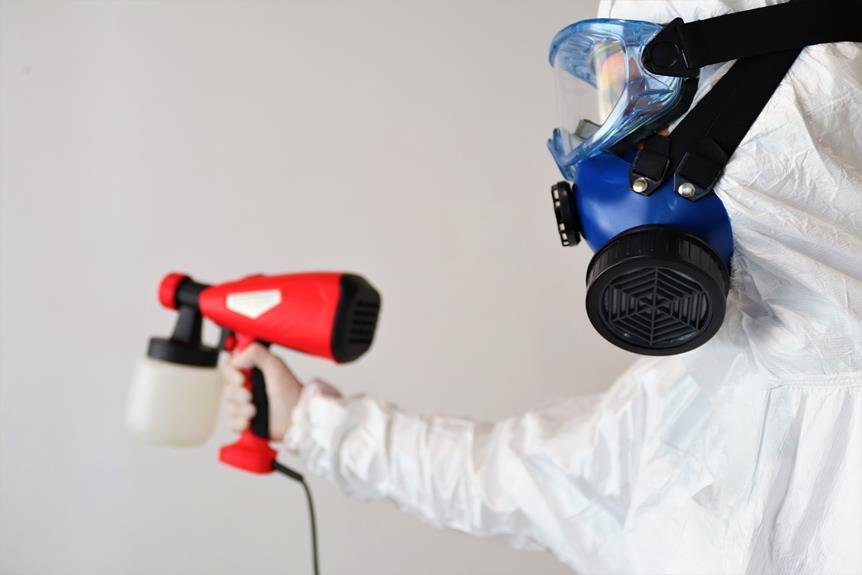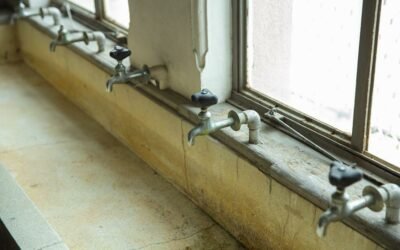Are you struggling with mold in your grow room? Don't worry, we've got you covered.
In this article, we'll show you how to prevent mold and keep your plants healthy.
With proper ventilation, humidity control, regular cleaning, and the use of mold-resistant materials, you can create an environment that is inhospitable to mold growth.
By implementing these strategies and managing water effectively, you'll be able to maintain a mold-free grow room and ensure the optimal growth of your plants.
Key Takeaways
- Proper ventilation and airflow are essential in preventing mold in a grow room.
- Regularly monitor and control humidity levels using a hygrometer.
- Use mold-resistant materials such as mold-resistant paint and fiberglass reinforced panels.
- Practice water management by avoiding overwatering, ensuring proper drainage, and using dehumidifiers or fans if needed.
Proper Ventilation and Airflow
Proper ventilation and airflow are essential for preventing mold in your grow room. Mold thrives in environments with high humidity and stagnant air, making it crucial to maintain proper air circulation. By providing adequate ventilation, you can effectively control humidity levels and reduce the risk of mold growth.
To ensure proper ventilation, start by installing exhaust fans in your grow room. These fans will help remove stale air and moisture, preventing them from accumulating and creating a conducive environment for mold. Additionally, consider using oscillating fans to promote air movement within the space. This will help distribute fresh air evenly and prevent pockets of stagnant air where mold can flourish.
It's important to monitor humidity levels regularly using a hygrometer. Aim for a relative humidity (RH) between 45% and 55% to inhibit mold growth. If the humidity exceeds this range, consider using dehumidifiers to remove excess moisture from the air. Conversely, if the humidity is too low, consider using humidifiers to maintain optimal conditions for your plants while avoiding mold issues.
Proper ventilation and airflow are fundamental in preventing mold in your grow room. By implementing these measures, you can create an environment that's inhospitable to mold growth, ensuring the health and success of your plants.
Monitor and Control Humidity Levels
To effectively prevent mold in your grow room, it's crucial to monitor and control humidity levels. Maintaining the optimal humidity range is essential for a healthy growing environment and to prevent the growth of mold and mildew. High humidity levels promote mold growth, while low humidity levels can lead to plant stress and slower growth.
To monitor humidity levels, you can use a hygrometer, a device that measures humidity in the air. Place the hygrometer in a central location within your grow room, away from any direct air vents or sources of moisture. Regularly check the hygrometer readings to ensure that the humidity remains within the desired range.
Controlling humidity levels in your grow room can be achieved through various methods. If the humidity is too high, you can use dehumidifiers to remove excess moisture from the air. Dehumidifiers work by condensing the moisture and collecting it in a reservoir. On the other hand, if the humidity is too low, you can use humidifiers to increase the moisture levels. Humidifiers release water vapor into the air, raising the humidity to the desired level.
Additionally, proper ventilation and airflow can also help regulate humidity levels. Good air circulation helps distribute moisture evenly and prevents stagnant air, reducing the risk of mold growth. Installing fans and air vents can improve airflow and maintain optimal humidity levels.
Regular Cleaning and Maintenance
Be diligent in regularly cleaning and maintaining your grow room to prevent mold. Mold thrives in damp and dirty environments, so it's essential to keep your grow room clean and well-maintained. Here are three important steps to follow:
- Clean surfaces regularly: Dust, dirt, and debris can accumulate on surfaces and provide a breeding ground for mold. Regularly wipe down walls, floors, and equipment with a mild detergent to remove any potential mold spores. Pay extra attention to corners, crevices, and hard-to-reach areas where moisture can accumulate.
- Check and clean ventilation systems: Proper airflow is crucial in preventing mold growth. Regularly inspect and clean your ventilation systems, including fans, filters, and ducts. Ensure that air is circulating effectively throughout the grow room, as stagnant air can create a favorable environment for mold. Replace filters as needed to maintain optimal air quality.
- Monitor and clean up spills promptly: Any water or nutrient spills should be addressed immediately. Moisture is one of the main contributors to mold growth, so it's essential to clean up spills promptly and thoroughly. Use absorbent materials to soak up any excess moisture and ensure that the area is completely dry.
Use Mold-Resistant Materials
When choosing materials for your grow room, opt for mold-resistant options to further safeguard against mold growth. Mold can thrive in environments with high humidity and organic materials, making your grow room susceptible to its growth. By using mold-resistant materials, you can minimize the risk of mold infestation and ensure a healthy growing environment for your plants.
Here are some examples of mold-resistant materials you can consider for your grow room:
| Material | Description |
|---|---|
| Mold-Resistant Paint | These paints contain antimicrobial properties that inhibit mold growth. They are ideal for walls and ceilings. |
| PVC Pipes | PVC pipes are resistant to moisture and can be used for irrigation systems, preventing mold formation in the plumbing. |
| Fiberglass Reinforced Panels (FRPs) | FRPs are moisture-resistant and easy to clean, making them suitable for walls and surfaces in your grow room. |
In addition to these materials, it is essential to ensure proper ventilation and maintain optimal humidity levels in your grow room. Regularly inspect the materials for any signs of damage or wear, as damaged materials can provide a breeding ground for mold. By investing in mold-resistant materials and practicing proper maintenance, you can create a mold-free environment for your plants to thrive.
Implement Proper Water Management
Maintain proper moisture levels to effectively manage water in your grow room and prevent mold growth. Proper water management is crucial in maintaining a healthy and mold-free environment for your plants. Here are three important steps to implement proper water management:
- Use a moisture meter: Regularly check the moisture levels in your grow room using a reliable moisture meter. This will help you determine whether the plants need watering or if the soil is too saturated, which can lead to mold growth. Aim for a consistent moisture level that's suitable for the specific plants you're growing.
- Avoid overwatering: Overwatering is one of the main causes of mold growth in grow rooms. Make sure to water your plants only when necessary and avoid excess water accumulation in the pots or trays. Ensure proper drainage by using well-draining soil and containers with sufficient drainage holes.
- Monitor humidity levels: High humidity levels can create a favorable environment for mold growth. Invest in a hygrometer to measure the humidity levels in your grow room. Ideally, aim for a humidity level of 40-60% to prevent excessive moisture and mold formation. Use dehumidifiers or fans to regulate humidity if necessary.
Conclusion
To prevent mold in a grow room, it's crucial to prioritize proper ventilation and airflow.
Monitoring and controlling humidity levels, along with regular cleaning and maintenance, also play a vital role in mold prevention.
Choosing mold-resistant materials and implementing proper water management are additional preventive measures.
By following these guidelines, growers can create a healthy and mold-free environment for their plants, ensuring optimal growth and harvest.






0 Comments